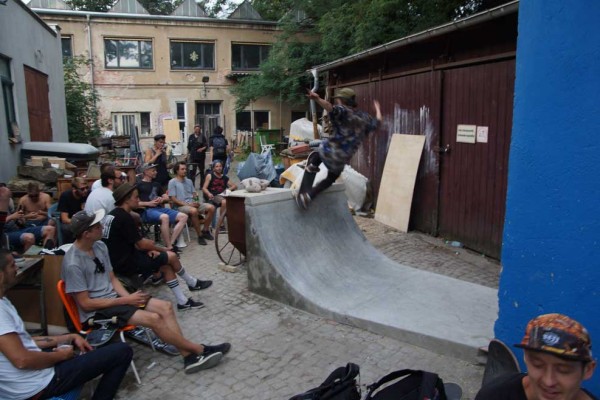Die Kunst, ein unendliches Feld der Abstraktionen und des indirekten Handelns. „Reclaim Your Brain“, welche als ein Outside-In für Künstler des Rollbrettes gesehen werden kann, transferierte Fragen zur konventionellen Kunstbetrachtung in den Ausstellungsraum und bildete dabei einen Ausgangspunkt zum erweitern des eigenen Verständnishorizontes.
Auffällig wurde das die konventionelle Kunstbetrachtung versagt, wenn das, was man als künstlerisch versteht, zur direkten Erfahrung und zum temporären professionellen Interagieren mit ausgestellten Exponaten wird. Skulptur, Malerei und Sound, alles war dabei, nur der gängige Kontext geriet ins bröckeln. Die Frage die dabei besonders in den Vordergrund rückte war, ob Kunst in ihrer Definition zwingend frei von einem konkreten Nutzen sein muss, um sich selbst noch als solche zu behaupten.

Dort wo gängiger Weise „Kunstwerke“ zur ausschließlichen Präsentation hin gelangen, wurde ein Parkkur im Ausstellungsraum errichtet, welcher Ausgangsbasis zum „künstlerischen“ tun darstellte. Schon beim Aufbau transformierte der heilige White Cube überraschend zu einer reinen Baustelle und das museale Flair wurde unbeachtet mit Lärm beschallt und Dreck beschmutzt und dabei die „Ansehnlichkeitsorientierung“ durch Nutzungsziele ersetzt. An dieser Stelle wurde das erste Mal mit der generellen Ausstellungslogik gebrochen und das übliche Drapieren fertiger Werke um wirkliche funktionelle Absichten bei der Herstellung der Exponate erweitert. Für das allgemeine zeitgenössische Kunstverständnis wären innerhalb der Aufbauphase die Ausstellungsräume des C. Rockefeller Centers ein Paradies unendlicher abstrakter Installationen gewesen, jedoch verharrten diese keineswegs in dieser Position.

„Kunst ist schön, aber mach was draus.“ Die Frage ob das kreative an der Kunst ja eventuell auch die bloße Einbildungskraft, was etwas Gezeigtes „sein könnte“ oder „darstellt“ ist, stand buchstäblich im Raum. Kunst passiert nicht, sie simuliert. So genommen könnte man diese Ausstellung als einen Angriff auf die konventionellen Begriffsgrenzen der Kunst verstehen und als einen Moment welcher diese erweitern kann, oder mindestens hinterfragt. Doch was ist schlecht daran wenn ein „Kunst nutzen“ über ein reines Gedankenanregen hinweg zu einem konkreten Erfahrungsmoment wird. Wenn die Skulptur fern ab von reinen ästhetischen Gesichtspunkten eine Oase des künstlerischen „agieren“ darstellt. Kann es dann noch Kunst sein? Ob „Reclaim Your Brain“ nun ein Versuch der Erweiterung des Kunstkontextes ist, oder ein Ausgangspunkt bildet über die Konventionen der Kunst nach zu denken ist egal, spannende Bezüge sind allemal durch diese Ausstellung eröffnet und ein tiefgründiger Blick auf das Kunstgenre des Rollbrettfahrens im normativen Kunstkosmos sowieso bis Dato extrem unterbelichtet.
Text: Lucie Freynhagen / C. Rockefeller Center

Art, an infinite field of abstractions and indirect action. „Reclaim Your Brain“, which can be seen as an outside-in for artists of the roller board, transferred questions about the conventional view of art into the exhibition space and formed a starting point for expanding one’s own horizon of understanding.
It became obvious that the conventional view of art fails when what one understands as artistic becomes a direct experience and a temporary professional interaction with exhibited objects. Sculpture, painting and sound, everything was there, only the conventional context crumbled. The question that came to the fore was whether art in its definition must necessarily be free of a concrete use in order to assert itself as such.

In the place where „works of art“ are usually presented, a park was erected in the exhibition space, which was the starting point for „artistic“ activities. Already during the construction, the sacred white cube surprisingly transformed into a pure construction site and the museum flair was unnoticed with noise and dirt, replacing the „attractiveness orientation“ with usage goals. At this point, the general exhibition logic was broken for the first time and the usual draping of finished works was expanded to include real functional intentions in the production of the exhibits. For the general contemporary understanding of art, within the construction phase, the exhibition spaces of the C. Rockefeller Center would have been a paradise of endless abstract installations, however, they by no means persisted in this position.
„Art is beautiful, but make something out of it.“
The question whether the creative in the art is possibly also the bare imagination, what something shown „could be“ or „represents“, literally stood in the room.Art does not happen, it simulates.Taken in this way, this exhibition could be understood as an attack on the conventional conceptual boundaries of art and as a moment that can expand them, or at least question them. But what’s wrong with „using art“ going beyond a mere thought-provoking moment to a concrete moment of experience. When the sculpture, far from purely aesthetic aspects, represents an oasis of artistic „acting“. Can it then still be art? Whether „Reclaim Your Brain“ is an attempt to expand the art context or a starting point to think about the conventions of art is irrelevant, exciting references are in any case opened by this exhibition and a profound look at the art genre of rollerboarding in the normative art cosmos anyway until now extremely underexposed.
Text: Lucie Freynhagen / C. Rockefeller Center

